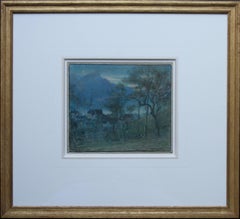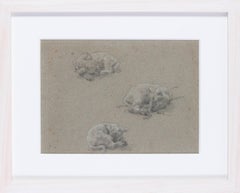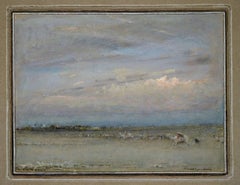Albert Goodwin Art
Albert Goodwin was a notable English landscape painter, specializing in watercolors.
Goodwin was born in Maidstone, in Kent, the son of a builder and one of nine children. After leaving school, he became an apprentice draper. His exceptional artistic ability was recognized at an early age and he went on to study with the Pre-Raphaelite artists Arthur Hughes and Ford Madox Brown with the latter predicting that he would become one of the greatest landscape painters of the age.
At the age of 15, Goodwin’s first painting was exhibited at the Royal Academy. He became an associate member of the Royal Watercolour Society (RWS) in 1876. He was championed by famed art critic John Ruskin, who took him on a tour of Europe, where he made many sketches from nature, which were later turned into watercolors. During his lifetime, he traveled extensively throughout Britain and Europe, and visited many other countries.
Goodwin was a prolific artist, producing over 800 works and continuing to paint well into his 80s. His wide variety of landscape subjects reflected his love of travel and showed the influence of Turner, with whom he felt a strong affinity. In later works, Goodwin developed experimental techniques, such as using ink over watercolor, to achieve atmospheric lighting effects. His works are also an important record of social history.
Find a collection of authentic Albert Goodwin watercolor paintings and other art on 1stDibs.
Late 19th Century Realist Albert Goodwin Art
Oil
19th Century Academic Albert Goodwin Art
Paper, Watercolor
1910s Impressionist Albert Goodwin Art
Watercolor
19th Century Albert Goodwin Art
Chalk, Pastel, Paper
19th Century Albert Goodwin Art
Watercolor
1910s American Impressionist Albert Goodwin Art
Paper, Watercolor
1950s Modern Albert Goodwin Art
Watercolor
Early 20th Century American Impressionist Albert Goodwin Art
Paper, Watercolor
1910s Naturalistic Albert Goodwin Art
India Ink, Paper, Watercolor
Gustav MelcherGustav Melcher ( German, 1898 -?) Boats off Venice Italy Ink Water Color c. 1918, 1918
Early 20th Century Impressionist Albert Goodwin Art
Paper, Pastel
1890s Academic Albert Goodwin Art
Watercolor, Archival Paper, Gouache
1970s Academic Albert Goodwin Art
Watercolor, Gouache, Archival Paper
1950s Modern Albert Goodwin Art
Watercolor
21st Century and Contemporary Realist Albert Goodwin Art
Canvas, Oil
21st Century and Contemporary Realist Albert Goodwin Art
Canvas, Oil
Early 1900s Realist Albert Goodwin Art
Paper, Pastel, Ink, Watercolor
Early 19th Century Academic Albert Goodwin Art
Watercolor, Pen, Ink, Paper





